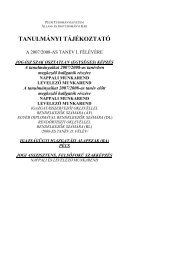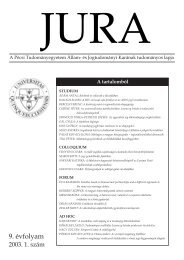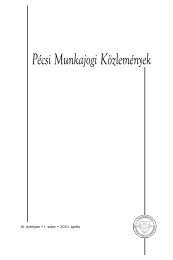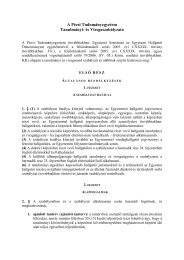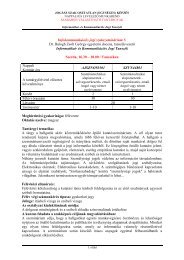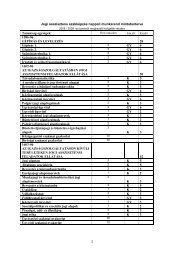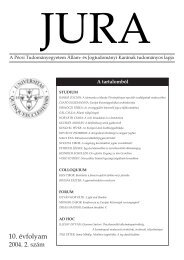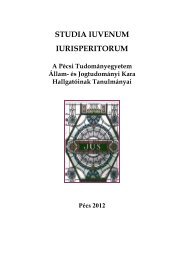2012. évi 2. szám - Jura - Pécsi Tudományegyetem
2012. évi 2. szám - Jura - Pécsi Tudományegyetem
2012. évi 2. szám - Jura - Pécsi Tudományegyetem
- TAGS
- jura
You also want an ePaper? Increase the reach of your titles
YUMPU automatically turns print PDFs into web optimized ePapers that Google loves.
Jorn van Rij: A Dutch Invitation: Hungarian Women Welcome?Jorn van Rijsenior lecturer of Criminology at INHollandUniversity of Applied Sciences in RotterdamA Dutch Invitation: HungarianWomen Welcome?1. IntroductionThis article looks at the transition of Dutch societyand the legalistic difficulties this has brought forth.It focuses towards the operation of organised crime,more specific the trafficking and forced prostitutionof Hungarian women working in the Netherlandsand seeks to stimulate discussion regarding combatingthis type of crime from both a Dutch, Hungarianand EU perspective.<strong>2.</strong> Background: Dutch societyThe Netherlands are, at least for a lot of people whonever have been there, commonly perceived as aSodom and Gomorra like society with an everlastingpresence of drugs and prostitution. And yes it’sa fact that the Dutch government has been lenienttowards these types of substance use and humanbehaviour, which are commonly (more) criminalisedin other countries then they are in the Netherlands,but this is explained by a short historical review. Atthe end of the 1960’s early 1970’s Dutch society wasin turmoil as at one hand the youth and on the otherhand the women were starting with (re-)conqueringtheir position within, a up until then, mostly whitemiddle-aged male orientated society. as a result ofthis cultural and feminist based non-violent revolutionto gain autonomy 1 , structural changes havebeen realised within Dutch society and also withinthe criminal legislation as they have triggered a (re)new(ed) interest in the victim as crucial part of thecriminal and penal process. The Dutch youth optedanother approach by being rebellious and by doing soturning themselves against dominant society whichup until then was structured upon a middle-agedwhite male perspective. They took on the Americanhippy culture with a positive attitude towards theuse of illegal stimulants i.e. marihuana and a liberalmoral towards sex as an example.In regards to the first, they started using differenttypes of drugs on such a wide scale, the policedecided not to act as this caused more social problems.This was motivated by the limited success rates239of prosecution and by extension when a case wasprosecuted s successfully, the sentencing was nextto nothing and in no relation to the deployment ofthe police. Eventually the police decided not to actand they started to condone the situation and onlyintervene in cases when a situation was beyond(informal agreed upon) limits. In the end these twosocial processes required legal action by an increasinglycornered government. 2 Instead of implementinglegislation focussing towards repression as otherEuropean countries like France and the UK did, theDutch government choose a path of de facto legalacceptance for drugs and a formal (de iure) approachfor prostitution as repression was seen unnecessaryand not feasible. For the practical implementationof legal measures regarding the drug(ab)use, thiseventually led to the commonly discussed and criticisedDutch Condone Policy towards several typesof grey list substances, also known as soft-drugs likeMarihuana. Beside this situation not of non-acting onsoft-drugs use and controlled sales, prostitution requireda different approach as the stakes i.e. women’srights requested legalisation. The profession of aprostitute as a woman’s choice and given right wasless criticised nationally and on a European level andbecame a formalised fact on the first of October 2000after more than two decades of debate and almost30 years after the entry into force of the Drug relatedCondone Policy. 3 With this legalisation, the initialidea was to minimise the influence of human traffickersand abolish forced prostitution. Interestingto know is that Sweden chose a completely differentapproach with the same goal. Instead of legalisationin 1999 they choose to fully criminalise and penalisethe purchase of sex by men. 4 Part of the Dutch approachof legalisation was that the women were seenas independent entrepreneurs who should registerthemselves at the Chamber of Commerce, pay taxesand by doing so would also benefit of the decriminalisationof the profession. These advantages existedout of accessible funded social health care andprotection and regulation out of labour law existingout of secondary benefits like a pension, disabilitycompensation and unemployment benefits. At thistime, both legal developments lacked a criminal andpenal base as they were approached out of a healthcare perspective in order to minimise risks of illness,addiction, abuse and death.This process of decriminalisation and legislationwas not flawless as European pressure led toseveral adaptations. The international pressure wasespecially noticeable within the drug orientatedCondone Policy as the French government used itsEuropean influence to put pressure on the Dutch. 5This eventually led to re-criminalising the so-calledJURA 2012/<strong>2.</strong>



